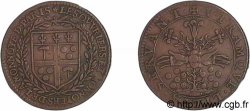v27_0374 - MAXIMIANUS HERCULIUS Follis ou nummus
MONNAIES 27 (2006)
Starting price : 150.00 €
Estimate : 250.00 €
Realised price : 275.00 €
Number of bids : 10
Maximum bid : 275.00 €
Starting price : 150.00 €
Estimate : 250.00 €
Realised price : 275.00 €
Number of bids : 10
Maximum bid : 275.00 €
Type : Follis ou nummus
Date: 10/307
Mint name / Town : Lyon
Metal : copper
Diameter : 26,5 mm
Orientation dies : 6 h.
Weight : 7,85 g.
Rarity : R3
Emission: 16e
Coments on the condition:
Exemplaire sur un flan large, bien centré des deux côtés. Magnifique portrait. Revers de très joli style fin. Magnifique patine verte et marron foncé lissée
Catalogue references :
Obverse
Obverse legend : D N MAXIMIANO P F S AVG.
Obverse description : Buste lauré et cuirassé de Maximien Hercule à droite, avec pan de paludamentum, vu de trois quarts en avant (B*01).
Obverse translation : “Domino Nostri Maximiano Pio Felici Seniori Augusti”, (À notre seigneur Maximien pieux heureux auguste le plus âgé).
Reverse
Reverse legend : GENIO - POP ROM/ S|C// PLG.
Reverse description : Genius (Génie) debout à gauche, coiffé du modius, le Génie porte l’himation, tenant une patère de la main droite et une corne d'abondance de la main gauche.
Reverse translation : “Genio Populi Romani”, (Au Génie du Peuple romain).
Commentary
Rubans convergents : rubans descendant verticalement le long de la nuque (type 3). Cuirasse cloutée. Épaulière cloutée. Les ptéryges sont larges. Un changement radical intervient dans la représentation du Génie au revers. Il est maintenant normalement revêtu de l’himation au lieu du manteau tombant sur l’épaule (paludamentum). Une autre innovation est l’apparition des lettres S|C dans le champ. Nous nous sommes interrogés sur la présence et la signification de ces lettres S C. Il pourrait tout simplement signifier “Senatus Consulto” (avec l’autorisation du Sénat) ? Nous n’avons relevé aucune liaison de coin pertinente.








 Report a mistake
Report a mistake Print the page
Print the page Share my selection
Share my selection Ask a question
Ask a question Consign / sell
Consign / sell
 Full data
Full data















